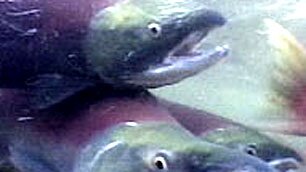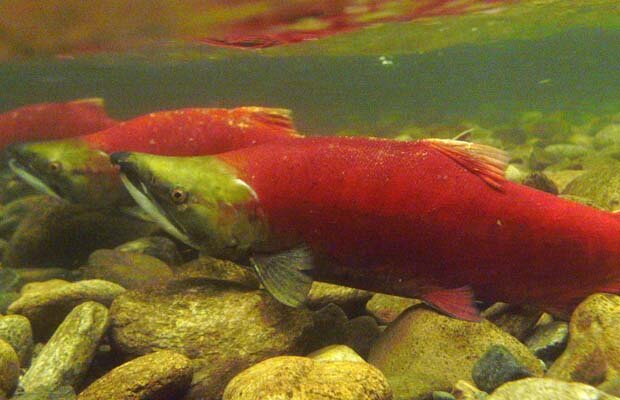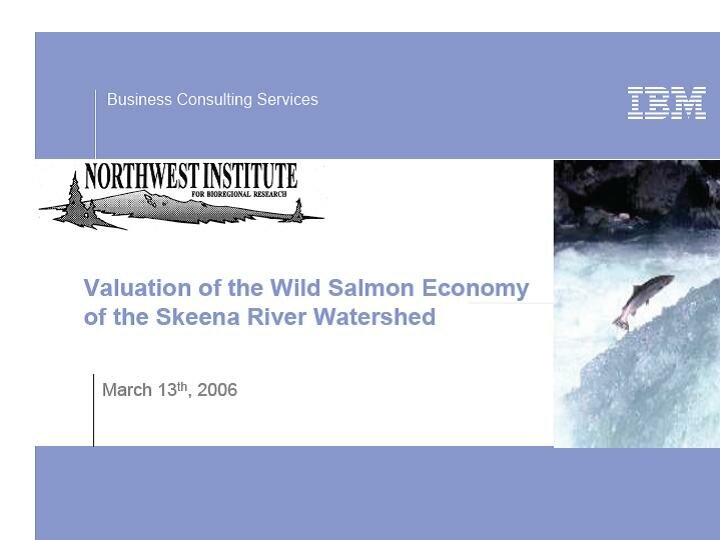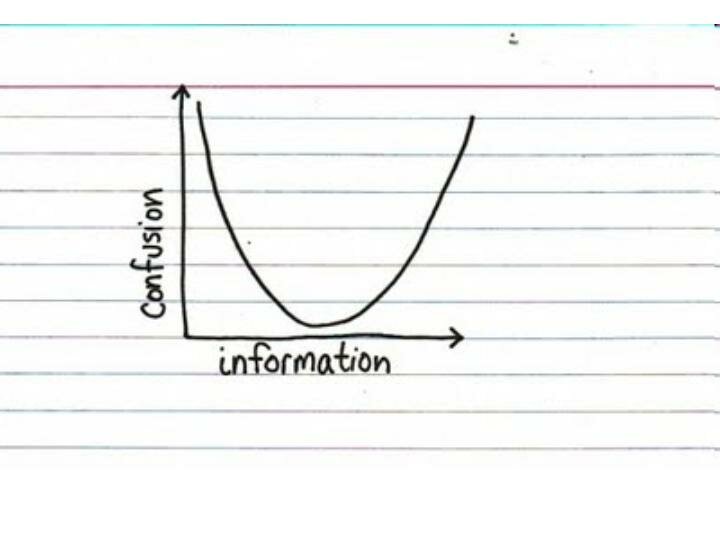has got a couple of great posts this last few days. Short, to the point, and leaving me pondering. Godin is generally referred to as a marketing guy – and he is – but really what aspect of our lives isn’t marketing, or affected by marketing…? Godin is also more than just marketing; he’s a thinker and now with his last few books running along the edge of motivational speaker.
Today’s post refers to the which are quite the thing – as the tagline to the talks suggests “Ideas worth spreading”. If you get a chance many of the talks are quite fascinating.
Godin’s post today starts with an algebraic equation and he highlights that during our school-age education we were being taught to “play with numbers in our head. Abstract numerical thought is an important skill among educated people.”
However, as Godin suggests listen to the TED talks and try to get ahead of the speaker….
basically, it’s similar to a quadratic equation. If you need the other person to slow down and explain every little bit, you’ve missed the point. The point is to do abstract conceptual thought. To get in practice taking the accepted status quo and questioning it, at least for a little while, at least this or that part of it.
I think this is a skill, a rare one. The ability to be facile in the manipulation of ideas, both theoretical and established, is a valuable one…
…The trick is to be able to leap to, “if we did A and B, would that get us C? Would C be a good thing? Is it possible to do A and B if we really commit?” and then move on to the next one. And that takes practice. Why wouldn’t it?
So let me throw this equation into the mix:
The simplest way to model harvesting is to modify the logistic equation so that a certain number of individuals is continuously removed:
-

Where H represents the number of individuals being removed from the population – that is, the harvesting rate.
This is one of the model equations for Maximum Sustainable Yield from Wikipedia. Personally, looking at this stuff makes me feel like… well… smashing my laptop screen down repeatedly on my fingers until I’m down a digit or two…
Maximum Sustainable Yield (MSY) is the dominant “concept” worldwide for “managing” fish populations and fisheries. It is even in United Nations documents and guidelines – and still in Canada’s Wild Salmon Policy.
Although it is widely practiced by state and federal government agencies regulating wildlife, forests, and fishing, MSY has come under heavy criticism … from both theoretical and practical reasons. The concept of maximum sustainable yield is not always easy to apply in practice. Estimation problems arise due to poor assumptions in some models and lack of reliability of the data . Biologists, for example, do not always have enough data to make a clear determination of the population’s size and growth rate. Calculating the point at which a population begins to slow from competition is also very difficult…
“Biologists do no always have enough data to make clear determination of the population’s size” – I restate this as this is key when it comes to wild salmon. There is a lot of water in the historical range of Pacific salmon. There are a lot of streams in the salmon range.
No fisheries management institution can – and ever has – physically counted all salmon that reach spawning grounds. Plus if you’ve ever seen a huge salmon run, there is no “counting” – it is all estimation. And let’s remember “estimation” means an opinion, or a rough calculation, or a “judgment based on one’s impressions”. This is not exact science.
As a management goal, the static interpretation of MSY (i.e., MSY as a fixed catch that can be taken year after year) is generally not appropriate because it ignores the fact that fish populations undergo natural fluctuations (i.e., MSY treats the environment as unvarying) in abundance and will usually ultimately become severely depleted under a constant-catch strategy. (Wikipedia)
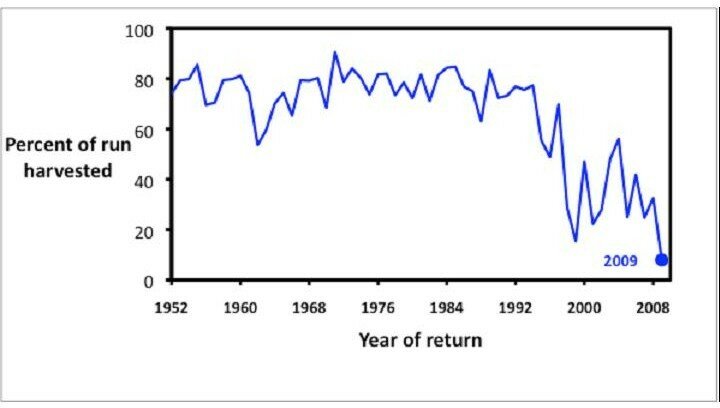 Here’s a graph from the “” press release from the Salmon “Think Tank” in December at Simon Fraser University.
Here’s a graph from the “” press release from the Salmon “Think Tank” in December at Simon Fraser University.
The graph shows the percentage of the Fraser River sockeye harvested over the last 50+ years. From the 50s to the 90s that percentage was in the range of 75-85% of the run.
Most numbers suggest that 90% of that is commercially harvested, 4-5% is First Nations harvest, and a small percentage is caught in sport fisheries.
Here’s a problem (or two).
A in relation to the Think Tank gathering:
More research and action is needed in the case of declining Fraser River sockeye stocks, according to a think-tank led by Burnaby academics. (my emphasis)
Well… if you buy into Godin’s line of thinking maybe that’s part of the problem? – too much abstract numerical thought and not enough abstract conceptual thought.
Here’s an equation to consider based upon Godin’s:
if we did A (fish the crap out of salmon runs for 50 years – as in take 80% of the population) and B (log, mine, throw pesticides in, draw water from for agriculture, urbanize the river mouth, etc. in salmon fresh water habitat) would that get us C (blown forecasts and potentially the lowest sockeye run in the history of the Fraser River) ?
Would C be a good thing?
And yet good respectable folks (many of which I have met and think highly of) are suggesting:
According to the think-tank, overfishing is not the reason productivity is declining.
So someone answer me this… how is it that a sockeye run of greater than 60 million in the early 1900s went to less than 1 million in a little over 100 years?
How is it that a population of First Nations anywhere between 2 million to 6 million prior to European contact throughout the Fraser River watershed (one of the most densely populated areas of North America prior to contact) was able to harvest anywhere between 10 million to 50 million salmon (approximately 8 fish per person) for a darn long time – sustainably?
No offense intended to those of you who have slaved on these issues for years – however, sometimes the thought processes that got us into a pickle need to be tossed out (sorry, recycled).
Maximum Sustainable Yield is a “concept” created in a time when smoking cigarettes was considered healthy, fireproof suits were made from asbestos, and dropping atomic bombs was considered an act of peace.
Time for new concepts.
And maybe it is time to blow the entire salmon discussion up? Maybe a lot less numerical thought and a lot more conceptual thought? Fewer scientists and “fish managers” and academics and a lot more local community folks, entrepreneurs, marketers, conflict resolution and facilitation experts, streamkeepers, artists and fishers, and definitely a lot more women, mothers, and creative thinkers.



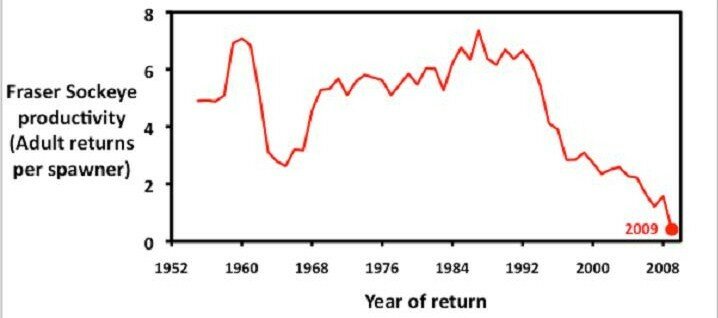
 This graph is showing sockeye salmon production in the Fraser. The steep red line running to the right hand bottom corner is worse than the steep red line to the bottom right corner of most of the world’s stock markets this time last year, or returns on most people’s RRSP.
This graph is showing sockeye salmon production in the Fraser. The steep red line running to the right hand bottom corner is worse than the steep red line to the bottom right corner of most of the world’s stock markets this time last year, or returns on most people’s RRSP.
